Wilhelmx2002
Administrator/Donator


Posts : 295
Join date : 2012-01-04
Age : 33
Location : Follow the wolf.. and you will find the beauty of nature.
 |  Subject: EMS Handbook Subject: EMS Handbook  Sat Jan 14, 2012 2:45 am Sat Jan 14, 2012 2:45 am | |
|  Medical Handbook Medical Handbook
To understand our working system you need to read step by step.
Handbook Contents
1. Introduction
2. Tutorial
3. First Aid and CPR
4. Medication
1. Introduction
This is the Medical Department original handbook. It contains valuable information for the public so that they know the penalties, but also for our paramedics. If you find that somebody is not following procedure then you may file a complaint against them.2. Tutorial
1. When receive a call and arrive at the scene, try to get a picture of the situation. This involves scene safety, treating immediate life threats, and making a diagnose of the patient. Always be sure to read the patient’s pulse and blood pressure.2. Second stage is establishing patient history, such as their chief complaint, signs and symptoms, any medications they take, allergies, past medical history, and events leading up to the incident.Minor injuries can be treated within the ambulance.Treat the wounds of the patient, this involves stitching minor wounds, clean and disinfect them, wrapping an arm into a sling, and he/she is good to go. Examples: Road RashThis is what happens when you get dragged across the road. Simple to treat, but quite painful for the patient.
- Control Bleeding.
-Irrigate with Sterile Water
- Apply a topical disinfectant.
- Wrap the wound in gauze.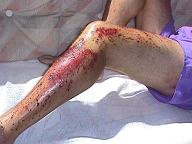 Major injuries patient is not in critical condition, but has to be taken to hospital. Major injuries patient is not in critical condition, but has to be taken to hospital.
When you’ve stabilised the patient, lift him on a stretcher, strap him on it and get the patient in the ambulance. If there are two EMT’s on the scene, be sure one will monitor the patient while driving to a hospital. Examples:Broken BonesAny type of fracture or crack in a bone.
- Control any bleeding.
-Elevate.
- Splint/Immobilize.
- Assess for Shock(hypoperfusion).
- Wrap in field dressings for large bones, gauze or small bones.
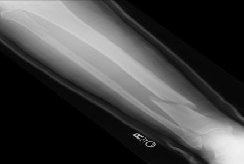
-Apply Oxygen at 15 L/min via a nonrebreather mask.Major injuries, patient is in critical condition, and has to be taken to hospital urgently.
Hand the patient over to the hospital personnel. Always mention the following things: the condition of the patient, whether he has been in cardiac arrest, what medication he’s received, other things the hospital personnel needs to know before treating the patient further:Bullet WoundsA bullet wound is a simple way of describing a puncture wound.
- Control Bleeding
- Do NOT remove bullet until in a hospital setting.
- Contact law enforcement.
-Assess for shock(hypoperfusion)-Apply Oxygen at 15 L/min via a nonrebreather mask.
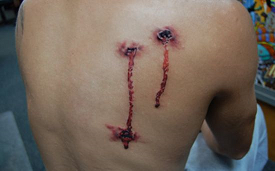 Deep CutsWhether it's from a knife or glass, it's deep. Deep CutsWhether it's from a knife or glass, it's deep.
- Control Bleeding and Stabilize any impaled object.
- Move the skin back into place and close it as much as possible.
- Suture the wound with a curved needle and stitches.
- Wrap the wound in gauze.-Apply Oxygen at 15 L/min via a nonrebreather mask.
-Assess for shock(hypoperfusion)
Drug OverdoseWhether they're out cold or seizing and foaming at the mouth, they're OD-ing.
- Secure the patient to the stretcher.
-Assess Mental Status
-Apply Oxygen at 15 L/min via a nonrebreather mask.-Contact Law Enforcement
-Immediate Transport
3rd Degree Burns3rd degree is a fatal injury over the body.
- Numb the area with morphine sulfate.
-Replace fluids via IV
-Apply Oxygen at 15 L/min via a nonrebreather mask.
- Apply dry sterile gauze.
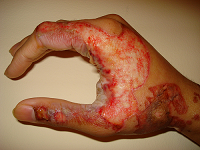
Controlling Bleeding
If you dont immediately treat bleeding the patient will die. Treating bleeding is a simple step in the medical service.
-Apply direct pressure with sterile bandaging
-Elevate the wound

Assessing for Shock(Hypoperfusion)
Signs and symptoms of shock include: Tachycardia(Fast heart rate) Hypertension(High BP) poor circulation and altered mental status. In treating shock you should:
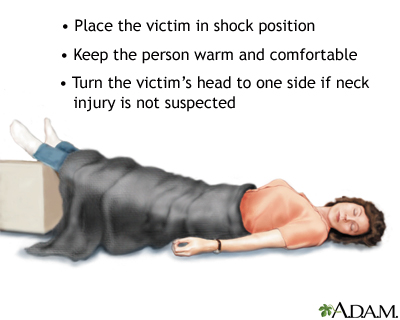
--Apply Oxygen at 15 L/min via a nonrebreather mask.-Place in the Trendelenburg's Position(on their back, feet elevated 12 inches.)
-Provide Warmth
Applying Oxygen
Oxygen is a "magical drug" it can help in any situation. In pretty much all medical and trauma cases you will apply oxygen to the patient. Turn on the Oxygen Tank in the ambulance unit. Attach the mask, set the flow to about 12-15 L/min and apply to the patient. 3. This is the time to celebrate you’ve been able to treat the patient. Get yourself a drink and get ready for more calls. In the case that you haven’t been able to save the patient, get a drink, and get over it. C-Spine Stabilization 3. This is the time to celebrate you’ve been able to treat the patient. Get yourself a drink and get ready for more calls. In the case that you haven’t been able to save the patient, get a drink, and get over it. C-Spine Stabilization
Upon the event of an MVA or a patient suffering a neck or back injury the patient needs immediate C-Spine stabilization. C-Spine Stabilization keeps the patients spine straight and lined up to prevent further spine injury that causes paralysis in the event of a possible spine injury. C-Spine stabilization should be done immediately after controlling bleeding, it can also be done by other personnel as another medic controls bleeding or provides other care.
It is VERY important that if the patient has a possible spine injury, that a person holds the neck until someone can attach a c-collar.

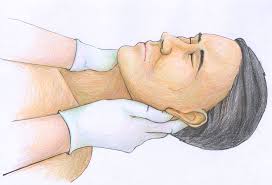
To stabilize the c-spine, follow these following steps:
-Hold the patients neck completely still and prevent any movement of the patient
-Apply a c-collar firmly on the neck, having someone hold the neck still throughout the procedure
-Have a partner assist you put the patient on a backboard by rolling the patient carefully on his/her side and sliding the backboard under
-Roll the patient back down and strap the patient in place using t-bands or straps if the backboard has them on
-Splint any broken bones
-Transport
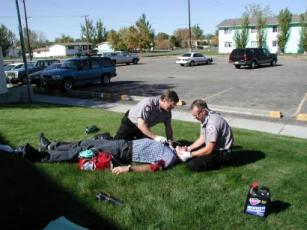
Fire department should be on scene at every MVA, take advantage of their presence and have them assist your unit.3. First Aid and CPR
First check for breathing. Other than blood, oxygen is the most important thing for the human body. A person can bleed to death in about 5 to 10 minutes from a large wound, but a person can suffocate in about 1-2 minutes. Try holding your breath as long as you can without hurting yourself. See how quick that was? Imagine how they feel. They don't even know they aren't breathing so it's up to you to take care of it. You can give your patient all the blood in the world, but if they aren't breathing then they just keeled over.
- It's very easy to check for breathing, either watch their chest, hold your ear next to their nose/mouth area and listen, or hold some bare skin next to their nose/mouth.
- If they aren't breathing then you need to get them breathing! GO through the standard procedure for CPR.
If you did all correctly pass to the heartbeat. Even if they aren't bleeding, their heart could be stopped and all the blood in the world couldn't save them. Check for a pulse. Here is a list of some of the many areas that you can check for a pulse:
- Wrist
- Pressure point under the jaw bone
- Pressure point on the collar bone adjacent to the base of the neck
- Inner elbow
- Inner knee
- Underneath the Achilles heel
Keep in mind low pulse means unconsciousness, massive blood loss, or low blood pressure (heart not beating enough). Normal simply means the victim is calm. High pulse simply means the patient is panicking. This can be expected from a conscious patient.
CPR can be used to get a patient to resume breathing or to restart a non-beating heart. When starting CPR, check the patient's airway. Just a simple look into their open mouth will do. If something is in there, just simply reach your finger in there and swipe it out. If it appears that something is forcing the throat open, but obstructing breathing then perform the Heimlich maneuver. About Heimlich maneuver:
If the victim is standing, stand behind them. Wrap your arms under their arms and around their waist. Form a fist with one hand, and place your thumb towards the victim. Grab the fist with your other hand and place your fist just above their belly button. Perform five upwards thrusts into the abdomen, each thrust strong enough to dislodge the foreign body. You are creating an artificial cough. Remain holding the victim as the victim will likely pass out in the event that the Heimlich Maneuver is ineffective. Repeat until foreign body is expelled. Be careful not to place your fist on the ribcage. This could break a rib and cause the rib to impale an organ.
If the patient still isn't breathing, perform a rescue breath. Do this by holding open their mouth and forcing two breaths into their lungs with your mouth. If you are in your ambulance, you can use a breathing apparatus called the Bag Valve Mask, or BVM, located in the third cabinet on the driver's side of the ambulance. Just simply pump the air via hand bag.

If the victim still is not breathing or their heart is not beating, perform 30 pectoral thrusts. Place one hand over the other and press the sternum into the chest approximately half-way through the torso. Perform the thrusts at approximately 2 thrusts per second. After 30 thrusts, check for breathing and a heart beat. If either are absent, perform 2 more rescue breaths followed by 30 more pectoral thrusts. After 3 tries and no heartbeat, get the defibrillator.
Remember:
A = Airway -1
B = Breathing -2
C = Compressions -30
AED - Automated External Defibrillation
Automated External Defibrillation is the definitive treatment for the life-threatening cardiac arrhythmias, ventricular fibrillation and pulse-less ventricular. tachycardia. In layman's term, you shock the patient back to life. Every unit has at least one AED. In the case of a Cardiac Arrest patient, an AED needs to be applied ASAP. Start by attaching the pads to the patients chest.
 Simply press the analyze button on the AED and the machine will analyze the patients heart Rhythm. If the patient is confirmed to be in cardiac arrhythmia, the AED will tell you "Shock advised" once it does, make sure the patient is clear of all contact from people and water, and apply the shock by pushing the shock button. Immediately check for a pulse after. It is important you have someone continue CPR during the entire procedure up to the shock, and immediately after if no pulse is found. Simply press the analyze button on the AED and the machine will analyze the patients heart Rhythm. If the patient is confirmed to be in cardiac arrhythmia, the AED will tell you "Shock advised" once it does, make sure the patient is clear of all contact from people and water, and apply the shock by pushing the shock button. Immediately check for a pulse after. It is important you have someone continue CPR during the entire procedure up to the shock, and immediately after if no pulse is found.
5. Medication
The following is a list of recommended medications for average cases. This should give you a feel of the strength of the medications. Personally issue them one does of the medication to last the patient until they are able to fill the prescription on their own time at a 24/7. Medications can be found in the left-most cabinet on the passenger side of the ambulance. Make sure to keep the mini-fridge well stocked with water bottles (located under the medicine cabinet).
* Pure Oxygen - Helps in every medical situation. * Advil/Tylenol - Good for fevers, minor headaches.
* Motrin - Good for migraines and minor pains.
* Loratab - Good for general pain such as a broken bone, tends to make patients drowsy, Low chance of addiction.
* Lidocain - Local anesthetic. Good for pain mangagement and stabalizing heart rhythm.
* Morphine Sulfate - Used to relieve moderate to severe pain
* Propofol - Local anesthetic.
* Asprin - Blood thinner. Prevent blockage of arteries.
* Nitroglycerin - Beta blocker. Dilates the blood vessels to improve circulation to the pulmonary arteries.
* Epinephrine - Used to prevent swelling during anaphylactic (allergic) reactions
* Ibuprofen - Allergy relief.* Activated Charcoal - Used for ingested poisions, Will induce comiting.* Amytal - Used for sedation of a combative patient. (puts them to sleep)[/COLOR] Kind Regards,
Dr. Lionel Lopez. Medic Instructor((CREDITS TO LIONEL LOPEZ)) | |
|





